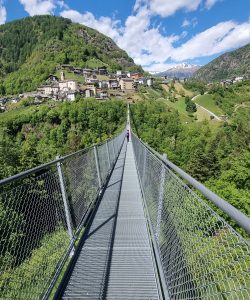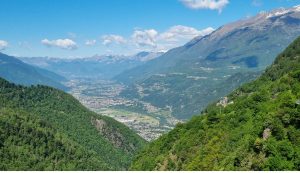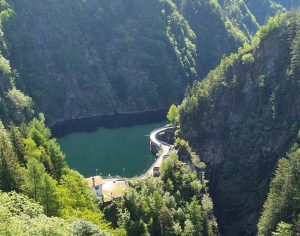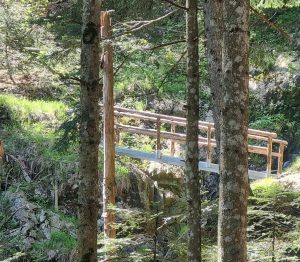Trekking in Lombardy – Tibetan bridge
Valtellina, besides being one of the main valleys of Lombardy, located in the heart of the Alps on the border with Switzerland, surrounded by the Rhaetian and Orobic chains, is dotted with numerous fascinating side valleys. One of these is undoubtedly the Tartano valley, which has become even more famous in recent years following the construction of the Tibetan bridge (Bridge in the Sky).

Having left the car in Campo Tartano, our trekking in Lombardy begins by crossing this footbridge of 234-metre-long, suspended at over 140 metres above the ground, making it the highest Tibetan structure bridge in Europe without lateral stabilising tie ropes.
You will be left breathless admiring the spectacular panorama that appears before your eyes while crossing the bridge. The view extends along a good part of Valtellina up to the northern part of Lake Como. On the opposite side we can admire the enchanting artificial lake created thanks to the damming of the Colombera dam.


The bridge path
Once we have crossed the bridge our trekking begins. It will take us to cross other minor bridges along a fascinating path. The first part is the most challenging. The path climbs inside the thick and lush forest where you cross the first small bridge (Punt d’il Pelandi), and then descends again to the Corna bridge from which you can admire the Tartano stream.


Going back up along the path we reach the Vicima bridge, probably the most evocative. Covered by an English lawn similar to a carpet, it ends with the entrance to a tunnel dug into the rock.

Continuing along the mule track and before returning to Campo Tartano, you cross the fifth and last bridge called Punt de la Pisaferia.
The entire route, which does not present any particular difficulties other than a minimum physical preparation, lasts about 2.30 – 3.00 hours. The only warning is that along the route there are no refreshment points or shelters.
A valley full of bridges and obviously water characterized by an intense green thanks to a lush vegetation.

